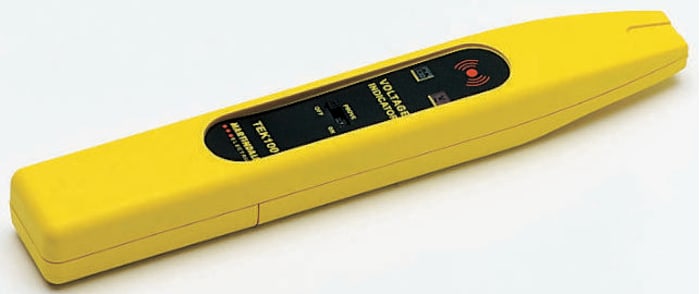RS PRO Non Contact Voltage Indicator 400V ac

Technical documents
Specifications
Brand
RS ProIndicator Type
Voltage
Battery Type
AAA
Power Source
Battery
Maximum Detection Voltage
400V ac
Maximum Operating Temperature
+50°C
Minimum Operating Temperature
-20°C
Product details
RS PRO Voltage Stick AC Indicator
RS PRO offers an ingenious pocket device voltage indicator for determining the presence of 50Hz AC voltages. These voltage indicators are battery powered pen style units with nylon tips that glow red when a voltage is detected.
There is no necessity for contact or for current to be flowing in order to activate this indicator. Ideal for finding:
- breaks in power cables
- checking plug wiring
- checking fuses
- distinguishing between live and neutral wires
- determining live cables in junction boxes
- finding faulty switches
- locating the faulty lamp in a series and many more
This voltage stick is one of the most essential safety proving units in an electrician’s tool kit, ensuring that it is safe for an electrician to start the electrical installation.
Options available include:
- 214-467 - 230V: range 220 to 400Vac (with respect to ground potential). The sensitivity is optimised for detecting 230V 50Hz mains voltages.
- 238-3571 - 110V: range 90 to 400Vac (with respect to ground potential). The sensitivity is optimised for detecting 110V 50Hz voltages as found in factory and other industrial applications.
Features and Benefits:
- Supplied with two AAA batteries
- Pen style design – small and compact easy to carry around in your pocket
- Clip for pocket or tool bag storage
Typical Applications:
Voltage indicators are hand-held proving devices that are used to test if a circuit is live or not. This is essential for carrying out electrical work at home or on the job to ensure there is no risk of electrocution when working with live circuits. Voltage indicators can include features such as an LED light or audible beep to identify the user of a live electrical presence. Proving units like these are commonly used by:
- Electricians
- DIY enthusiasts
FAQs
What is a non-contact voltage tester used for?
Voltage testers or detectors are used to check the flow of current through a circuit. They can be used to check safety, or to ensure equipment is functioning correctly. They can also test for the current strength, whether the circuit is grounded correctly or to ensure no current is flowing at all so that work can be begin on the circuit.
How do non-contact voltage testers work?
Also known as a voltage detector, voltage tester pens, sensors or test pens. They allow the user to test electrical conductors without touching them. Non-contact testers are the safest and easiest way to detect electric fields or voltage. Voltage testers utilise what is called capacitive coupling, the user holding the instrument provides a ground reference. The tester then detects changing electric field around the object or objects conducting an AC current. (Alternating current) Simply put, the user and the tester pen when near the electrical conductor will cause a small current to flow through the tester from the source, this is how it detects AC voltage.
Why RS PRO?
RS PRO is our own brand range and brings you a wide range of high-quality, great value products offering you more choice. Trusted by engineers all over the world, every part of every RS PRO product has been rigorously tested against demanding industry standards; they’re only given the RS PRO seal of approval if we’re confident of their exceptional quality, which means you can be confident too.

P.O.A.
1
P.O.A.
Stock information temporarily unavailable.
1
Stock information temporarily unavailable.

Technical documents
Specifications
Brand
RS ProIndicator Type
Voltage
Battery Type
AAA
Power Source
Battery
Maximum Detection Voltage
400V ac
Maximum Operating Temperature
+50°C
Minimum Operating Temperature
-20°C
Product details
RS PRO Voltage Stick AC Indicator
RS PRO offers an ingenious pocket device voltage indicator for determining the presence of 50Hz AC voltages. These voltage indicators are battery powered pen style units with nylon tips that glow red when a voltage is detected.
There is no necessity for contact or for current to be flowing in order to activate this indicator. Ideal for finding:
- breaks in power cables
- checking plug wiring
- checking fuses
- distinguishing between live and neutral wires
- determining live cables in junction boxes
- finding faulty switches
- locating the faulty lamp in a series and many more
This voltage stick is one of the most essential safety proving units in an electrician’s tool kit, ensuring that it is safe for an electrician to start the electrical installation.
Options available include:
- 214-467 - 230V: range 220 to 400Vac (with respect to ground potential). The sensitivity is optimised for detecting 230V 50Hz mains voltages.
- 238-3571 - 110V: range 90 to 400Vac (with respect to ground potential). The sensitivity is optimised for detecting 110V 50Hz voltages as found in factory and other industrial applications.
Features and Benefits:
- Supplied with two AAA batteries
- Pen style design – small and compact easy to carry around in your pocket
- Clip for pocket or tool bag storage
Typical Applications:
Voltage indicators are hand-held proving devices that are used to test if a circuit is live or not. This is essential for carrying out electrical work at home or on the job to ensure there is no risk of electrocution when working with live circuits. Voltage indicators can include features such as an LED light or audible beep to identify the user of a live electrical presence. Proving units like these are commonly used by:
- Electricians
- DIY enthusiasts
FAQs
What is a non-contact voltage tester used for?
Voltage testers or detectors are used to check the flow of current through a circuit. They can be used to check safety, or to ensure equipment is functioning correctly. They can also test for the current strength, whether the circuit is grounded correctly or to ensure no current is flowing at all so that work can be begin on the circuit.
How do non-contact voltage testers work?
Also known as a voltage detector, voltage tester pens, sensors or test pens. They allow the user to test electrical conductors without touching them. Non-contact testers are the safest and easiest way to detect electric fields or voltage. Voltage testers utilise what is called capacitive coupling, the user holding the instrument provides a ground reference. The tester then detects changing electric field around the object or objects conducting an AC current. (Alternating current) Simply put, the user and the tester pen when near the electrical conductor will cause a small current to flow through the tester from the source, this is how it detects AC voltage.
Why RS PRO?
RS PRO is our own brand range and brings you a wide range of high-quality, great value products offering you more choice. Trusted by engineers all over the world, every part of every RS PRO product has been rigorously tested against demanding industry standards; they’re only given the RS PRO seal of approval if we’re confident of their exceptional quality, which means you can be confident too.



